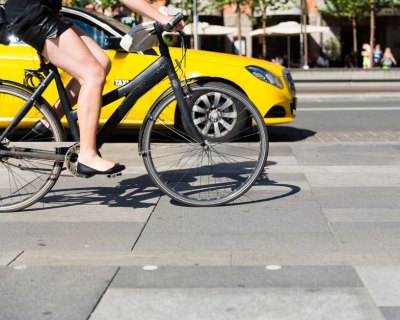
Are roads bicycle friendly?
It was August. I pedaled along on my daily commute to work at 15 mph. A quick glance over my left shoulder alerted me to an approaching vehicle. Just as I turned my head fully forward again, my front wheel fell hard into a deep but short hole in the pavement. A mountain bike is built to take a couple of bumps, but not like this. A witness in the car behind me said it looked as though my front wheel had disappeared into the pavement.
Indeed, the front wheel came off as the axle bent. The cycle’s forks hit the asphalt. I flew over the handlebars, landing on the right frontal area of my helmet. My first thought was, “Oh no, I’m landing on my head.”
What followed is a blur. My feet were no longer clipped onto the pedals. My glasses were in pieces on the road. I had come to rest on my left side. Pain pulsed through the right side of my neck, head and right shoulder.
The minute I tried to move I was in pain. I decided to remain still so as not to make the injury worse. There on the asphalt, I took stock of the injuries to my head and neck.
A crowd had assembled and passersby were on their cell phones summoning help. An ambulance sped to the scene. The remnants of my helmet were removed, and within minutes I was en route to the hospital on a backboard and with a cervical collar in place.
Two months have come and gone, and I am just now resolving chronic headaches and vertigo, as well as a slow-healing foot fracture. But at the forefront of my thoughts is how fortunate I am to be able to go on with my life.
I have had plenty of days off to think about what happened, and during that time I've read about road conditions that put cyclists in hospitals.
Municipal leaders like to think of their towns as eco-friendly havens where workers commute by bike. But whether this rosy notion is supported by local, statewide and national infrastructure is another matter.
Even in communities such as Berkeley, California, a university town historically friendly to bicycle traffic, routine commutes can turn deadly. Notably, Shlomo Bentin, 65, a University of California visiting professor and much-respected neuropsychologist, died July 13, 2012, after he was jarred by a passing truck and went over the handle bars.
Bentin’s death made international headlines. He was a prominent figure in neuropsychology. But there are plenty of other crashes that go unnoticed. State requirements for reporting bicycle accidents vary. The Federal Highway Administration concluded that many cycling-related injuries requiring medical attention go unreported.
If a car collision or ambulance ride is involved, however, there is a report somewhere. According to the U.S. Transportation Department, 726 bicycle crash deaths occurred in 2012 in the United States. This represents an increase of 6 percent over the year before. Roughly 600 to 780 cyclists have died each year during the past decade.
In my case, police and EMS quickly arrived at the scene. A security guard who witnessed the accident reportedly described it to the police. But no motor vehicles were involved in the crash, so a report was not required. The city’s public works department did not become aware of the problem until weeks later when I called to find out if the department knew about the bad road conditions in the area.
Most roadways in the U.S. are congested, potholes are common and there are no significant plans to improve mass transit. The American Society for Civil Engineers’ 2013 Report Card for America’s Infrastructure notes current funding allocations for road maintenance are not only insufficient to improve standards, but road conditions are expected to decline. The Infrastructure Report Card gives D's for both the roadways and mass transit sections.
So where does this leave cycling commuters?
I’ve come to realize that even as community leaders tell us they want us to take our bikes to work, they aren’t doing much to make that possible. So for the time being, I’m taking my car.
Related:
Bicycle commuters encounter obstacles
Cartoon Truth: A path around our potholes
Also by this author: